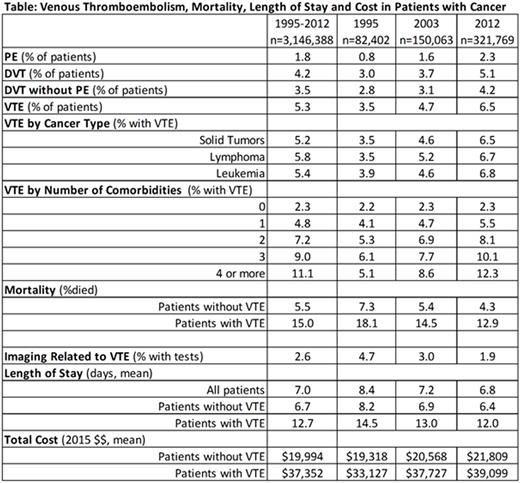Background: Venous thromboembolism (VTE) represents a leading cause of morbidity and mortality among hospitalized patients with cancer.
Methods: Hospitalization data reported on adult cancer patients at US academic medical centers and affiliated hospitals between 1995 and 2012 were analyzed. Cancer diagnosis, presence of VTE, comorbidities and complications were based on ICD-9-CM codes. Major comorbidities considered were diabetes, and cerebrovascular, peripheral-vascular, heart, liver, and lung renal disease. In patients with multiple hospitalizations during the time period, a randomly selected hospitalization was utilized in the analysis. Hospitalization cost estimates were inflation adjusted to 2015 US dollars.
Results: Nearly 6 million hospitalizations of 3,146,388 individual patients with cancer from more than 200 institutions were evaluated. VTE was reported in 8.4% of patients when all admissions are considered during the time period. When a single selected hospitalization is considered for each patient, VTE was reported in 166,547 (5.3%) of individual patients including 56,125 (1.8%) with pulmonary embolism (PE). The annual rate of VTE increased progressively from 3.5% in 1995 to over 6.5% in 2012 with the rate of PE nearly tripling from 0.8% in 1995 to 2.3% in 2012. For hospitalized patients receiving cancer chemotherapy, the annual rate of VTE more than doubled from 3.6% in 1995 to 8.3% in 2012. VTE was reported in 5.2%, 5.8% and 5.4% of patients with solid tumors, lymphoma, and leukemia, respectively (Table). Rates of VTE were greatest among patients with pancreatic (10.2%), gastric (7.1%) or other abdominal malignancies except colorectal cancer (9.2%) as well as those with ovarian (7.1%), lung (6.8%) and esophageal cancers (6.3%). The risk of VTE increased progressively from 2.3% in those with no comorbidities to over 11% for patients with 4 or more comorbid conditions. The strongest risk factors for VTE were infectious complications including sepsis (14%), invasive candidiasis (16%), pneumonia (11%) and IV line infections (14%).During this same time period, imaging related to VTE actually decreased with significantly lower rates of CT, vascular ultrasound and ventilation perfusion lung scans reported. In-hospital mortality was reported in 5.5% of cancer patients without VTE and in 15.0% of those with VTE including 19.4% of those with pulmonary embolism. In-hospital mortality during this time period decreased by approximately one-third in cancer patients both with and without VTE. While reported rates of VTE increased, the length of hospital stay shortened for patients with as well as without VTE during this period. Average costs per hospitalization adjusted to 2015 dollars for patients with and without VTE were $37,352 and $19,994, respectively. The estimated average inflation adjusted daily cost of hospitalization for patients with cancer and VTE increased nearly 50% between 1995 ($2,256) and 2012 ($3,297).
Conclusions: VTE reported among hospitalized patients with cancer has increased significantly during the period of observation along with the cost of hospitalization while in-hospital mortality and imaging rates have decreased. However, patients with additional major medical comorbidities are at exceptionally high risk of serious complications including in-hospital mortality.
Lyman:Amgen: Research Funding. Kuderer:Janssen Scientific Affairs, LLC: Consultancy, Honoraria.
Author notes
Asterisk with author names denotes non-ASH members.


This feature is available to Subscribers Only
Sign In or Create an Account Close Modal